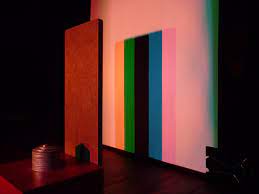 By: Martin Sagendorf
By: Martin Sagendorf
We see hundreds of colors, but the colors we think we see are often not what we’re actually seeing – i.e. many of these colors are combinations of other colors. ‘Light’s Story’ is fascinating and full of surprises. It begins with knowing that radiating and re-radiating substances emit light. The light colors emitted are functions of a number of factors: the substance, or the incident light, or the temperature of an incandescent source.
All the textbooks explain ‘additive’ and ‘subtractive’ colors. Explanations are fine, but actual experience makes both an immediate impression and a very lasting learning experience. For example, here’s how only RED, GREEN, and BLUE light colors combine to produce two new unexpected colors.
But we’re getting ahead of ourselves… let’s start with something we’re really familiar with: pigment colors. We all know that mixing different paint (pigment) colors will produce new colors. For example, when we mix red and green pigments we ‘see’ brown. And, as everyone knows, mixing a wide range of pigment colors will produce the ‘color’ we see as black. But, odd things happen when we mix two light colors. We don’t get the same color that we obtained when we mixed pigments.
When we mix red and green light colors we don’t ‘see’ brown: we see yellow! How can this be? Then… even though it does appear even more counter-intuitive, the mixing of all light colors produces the color we ‘see’ as white (but has NO color? – white… or does it?).
Wow!
How can this be discrepancy be explained? It’s a wonderful combination of physics and biology.
Briefly:
Physics explains the radiation, absorption & re-radiation of light energy. Every material (element or combinations thereof), when suitably excited, re-emits specific wavelengths (colors) of light, and it can also re-radiate (and absorb) wavelengths we can’t see – like Infrared. Also, a highly ‘excited’ material radiates light as a function of its thermal activity (as measured by its temperature).
Biology explains how our eyes interpret various combinations of light colors. Our eyes combine light of differing wavelengths to produce colors we perceive as ‘new’ colors. As above, when our eyes simultaneously receive light of both red and green wavelengths, we ‘see’ yellow. Fortunately, it’s rather easy to perform wonderful demonstrations of light’s behavior in both light realms.
Pigment Demonstrations:
Using varied choices of paint, mix assorted combinations of (pigment) colors to ‘see’ the resulting colors. Then mix only red, green and blue pigments… What color is achieved? – a sort of black? Not unexpected, but remember, these are reflective elements. They are absorbing and (selectively) re-radiating (or maybe not) specific colors (wavelengths of light). In this case, this combination of pigments absorbs virtually all the (visible) colors, thus we ‘see’ almost nothing. And when we have a yellow surface illuminated by white light, it is actually a surface that is absorbing the blue wavelengths and re-radiating only the red and green wavelengths of the incident white light – which we then ‘see’ as yellow.
Light Demonstrations: The Three Port Light Source
Using multiple light sources, or a single source that provides a selection of individual light colors, mix – red, green, and blue light colors… What color is obtained? –white? Remember, computer monitors and TV screens have only red, green and blue light – emitting elements – To make a white ‘color’ all three elements are energized. And to make black, no color elements are energized.
A single light source incorporating three light beams, each with selectable filters, and two mirrors is very flexible and very convenient to use.
This light source is relatively easy to construct: The design is detailed in the book Physics Demonstration Apparatus: the ‘Three Port Light Source’. It incorporates a 100 Watt Halogen light bulb within a large cookie tin having three 1-1/8 inch diameter light exit openings (each located at the height of the bulb’s filament and spaced 90 degrees apart), a four inch box fan and, outside each opening, six selectable ‘color paddles’. Two external mirrors are used to direct the two side light beams towards the projection screen.
The fan is very necessary because the ‘visible light’ efficiency of an incandescent bulb is only about 10% – the remainder of the bulb’s energy output (roughly 90 Watts) is Infrared (heat) which must be removed from the unit. The fan maintains the unit’s top plate at a temperature just warm to the touch.
The fan serves to draw air from below the unit, up through the bulb chamber, and outwards under the lower of the top plates.
In addition to simply ‘mixing’ two or three colors, a variety of objects can be placed between the Three Port Light Source and the projection screen – often producing quite unexpected light color patterns. The large dimensions of this demonstration allows the placing of students’ hands within in the light paths to provide very dynamic interactions between students and a real physics experience.
Hundreds of students have experienced the wonders of this apparatus. Without exception, their reactions have been ones of pure amazement and a better appreciation of the wonders of light.
Guidelines for building the Three Port Light Source are detailed in the book Physics Demonstration Apparatus. This amazing book is available through Educational Innovations and includes ideas and construction details, including all equipment necessary, for the creation and use of a wide spectrum of awe inspiring physics demonstrations and laboratory equipment. Included are 48 detailed sections describing hands-on apparatus illustrating mechanical, electrical, acoustical, thermal, optical, gravitational, and magnetic topics. This book also includes sections on tips and hints, materials sources, and reproducible labels.








Mr. Sagendorf explains construction and phenomenon clearly and simply making the learning experience a true pleasure.